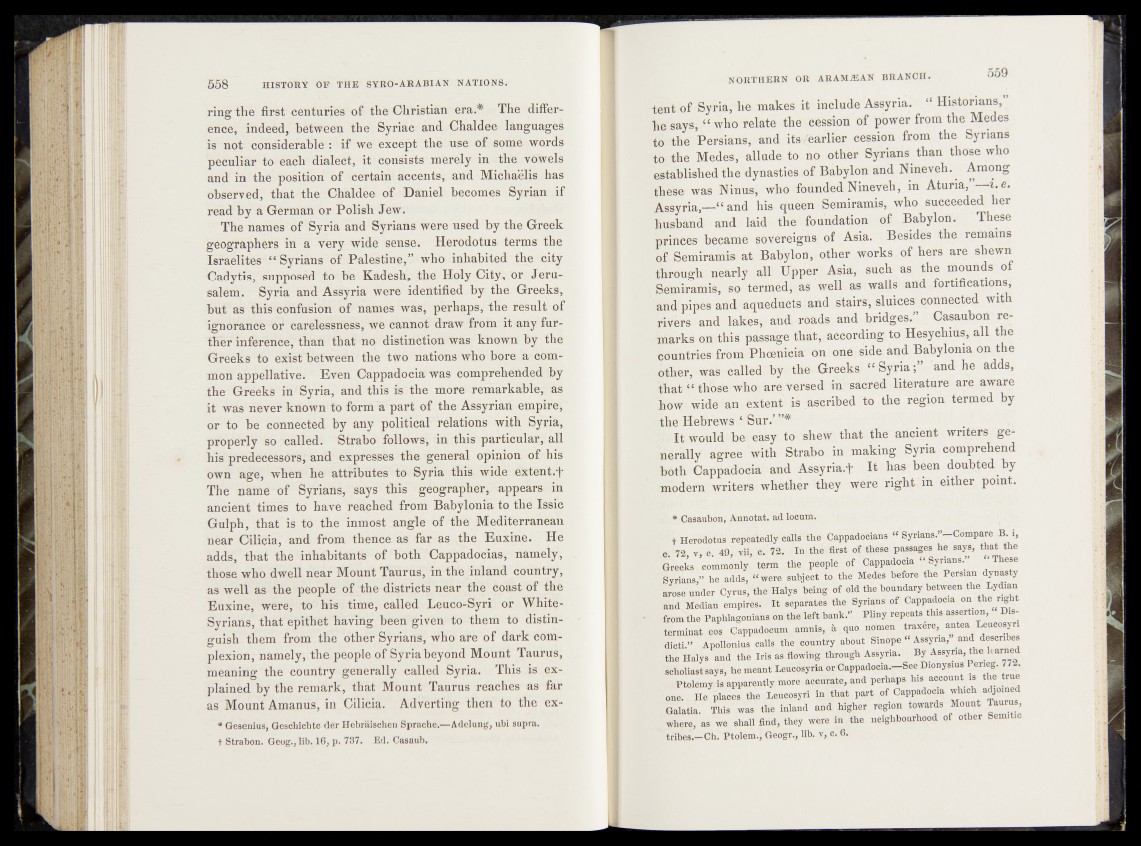
ring the first centuries of the Christian era.* The difference,
indeed, between the Syriac and Chaldee* languages
is not considerable: if we except the use of some words
peculiar to each dialect* it consists merely in the vowels
and in the position of certain accents, and Michaelis has
observed, that the Chaldee of Daniel becomes Syrian if
read by a German or Polish Jew.
The names of Syria and Syrians were used by the Greek
geographers in a very wide sense. Herodotus terms the
Israelites “ Syrians of Palestine,” who inhabited the city
Cadytis, supposed to be Kadesh, the Holy City! or Jerusalem.
Syria and Assyria were identified by the Greeks,
but as this confusion of names was, perhaps, the result of
ignorance or carelessness, we cannot draw from it any further
inference, than that no distinction Was known by the
Greeks to exist* between the two nations who bore ’a common
appellative. Even Cappadocia was comprehended by
the Greeks in Syria, and this is the more remarkable, as
it was never known to form a part of the Assyrian empire,
or to be connected by any political relations with Syria,
properly so ^called. Strabo follows, in this particular,; all
his predecessors, and expresses the general opinion of his
own age, when he attributed to Syria this wide textent.f
The name of Syrians, .says this geographer, appears in
ancient times to have reached from Babylonia to the Issic
Gulph, that is to the inmost angle of the Mediterranean
near Cilicia, and from thence as far as ,the Euxine. He
adds, that the inhabitants of both Cappadocias, namely,
those who dwell near Mount Taurus, in the inland country,
as well as the people of the districts near the coast of the
Euxine, were, to his time, called Leuco-Syri of White-
Syrians, that epithet having been given to them to distinguish
them from the other Syrians, who are of dark complexion,
namely, the people of Syria beyond Mount Taurus,
meaning the country generally called Syria. This is explained
by the remark, that Mount Taurus reaches as far
as Mount Amanus, in Cilicia. Adverting then to the ex-
* Gesenius, Geschichte der Hebräischen Sprache.—Adelung, ubi supra,
t Strabon. Geog., lib. 16, p. 737. Ed. Casaub.
tent of Syria, he makes it include Assyria. “ Historians,
he says, “ who relate the cession of power from the Medes
to the Persians, and its /earlier cession from the Syrians
to the Medes, allude to no other Syrians than those who
established the dynasties of Babylon and Nineveh. Among
these was Ninusv who founded Nineveh, in Aturia,” i.e.
Assyria,—“ and h i^ quëen Semiramis, who succeeded her
husband and laid the -foundation of Babylon. These
princes became sovereigns of Asia. Besides the remains
of • Semiramis at Babylon ?|«ther works of hers are shewn
through nearly all Upper Asia, such as the mounds o
Semiramis, s^ termed;- as well as walls and fortifications,
1 and pipes and aqueducts and stairs, sluices connected with
rivers and lakes, and roads and bridges.” Casaubon remarks
on this passage that, according to Hesychius, all the
countries from Phoenicia on one side and Babylonia on the
other, was called by the Greeks “ Syria ;”, and he adds,
that “ those who are versed in sacred literature are aware
•bow wide an extent is ascribed to the région termed by
the Hebrews ‘ Sur.’ .
It would be easy to shew that the ancient writers generally
agree with Strabo in making Syria comprehend
both Cappadocia and Assyria.f It has béen doubted by
modern writers whether they were right in either point.
; * Casaubon, Annotât, ad locum.
t Herodotus repeatedly calls the Cappadocians « Syrians.”—Compare B .i,
e. 72 v.' c. 49, vii, e. 72. In the first of these passages he says, that the
Greeks commonly term the people of Cappadocia “ Syrians.” ‘‘These
Syrians,” he adds, “ were subject to the Medes before the-Persian dynasty
arose under Cyrus, the Halys being of old the boundary between the Lydian
and Median empires. I t separates the Syrians of Cappadocia on the right
from the Paphlagonians on the left bank.” Pliny repeats this assertion, D é terminât
eos Cappadophm amnis, à ,quo nomen t r a i r e , antea I^uCosyri
dicti.” Apollonius calls the country about Sinôpe Assyria, and describes
the Halys and the Iris as flowing through Assyria. By Assyria, the learned
scholiast says, he meant Leucosyria or Cappadocia.—See Dionysius Perieg. 772.
Ptolemy is apparently, more accurate, and perhaps his account is the true
one. He places the Leucosyri in th a t part of Cappadocia which adjoined
Galatia. This was the inland and higher region towards « g Q
where, as we shall find, they were in the neighbourhood of other Semitic
tribes.—Ch. Ptolem., Geogr., lib. v, c. 6.